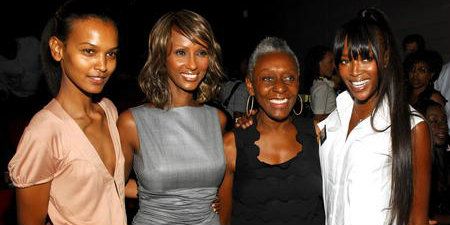Lacking a Reflection: The Homogeneity of Images of Beauty within the Fashion Industry

by Amber Johnson
The trajectory of race relations in the United States has been and will continue to be anything but smooth. In terms of public relations and cultural reconciliation, great strides have been made as is shown by the de-segregation of schools and public spaces and the strike down of anti-miscegenation laws. However, systemic discrimination and unconscious bias are still very much imbedded in the American society. This discrimination and bias are apparent in many forms, but one of the most current forms exists in the fashion world.
Models Naomi Campbell and Iman have started a coalition to counteract the lack of diversity on the runway. According to Naomi Campbell, diversity in the fashion industry has actually decreased throughout her career. At the peak of her career in the late 80’s and early 90’s, she remembers modeling with Asian, black, and white models from around the world, but today only “6% of designs were modeled by black models at the most recent New York Fashion Week and many of the world’s top fashion brands have one or no models of color on contract.” In order to remedy the situation, models Iman and Naomi Campbell and former agent Bethann Hardison have started the Diversity Coalition in order to raise awareness of the issue of racism in the fashion industry, “identify fashion houses and designers that consistently use one or no models of color in their runway shows,” and start the conversation about how to remedy the issue. They are trying to increase the opportunities for women of color in the industry, and fight the “tokenistic attitude towards diversity” that many fashion houses seem to have towards models of color, where a single model is often the only person of color featured in a fashion show. These models often feel that they are chosen because of their race instead of their talent.
The lack of diversity in the fashion industry is an important issue because the images of what constitutes beauty in America affect my self-esteem and self-perception of and young women like me. Growing up, I saw very few images of black women, and specifically dark-skinned black women in fashion. All the models in magazines such as Seventeen and TeenVogue were tall, skinny, white, and usually blonde, and when there was the rare black model, she was completely Europeanized with light skin and long straight hair, an image that did not at all connect with me personally. Luckily, I grew up in a household where an Essence magazine or a Jet monthly issue was always on hand, so I had some protective cultural barriers to the inundation of white images of beauty. The search for make-up and hair products that worked for me was difficult, and I often had to purchase more expensive brands because products were made for white women and light- skinned women, and girls with less unruly hair. I had a perm for ten years, and when I went natural, I had no idea what products to use to cater to the different texture and styling capabilities of my hair.
Latino author Junot Diaz once said “if you want to make a human being into a monster, deny them, at the cultural level, any reflection of themselves.” Constantly not seeing myself in images of what is supposed to be beautiful and admired made me feel as though there was something wrong with being who I am, and that I should be ashamed of what I looked like. Finding beauty in my personal appearance, regardless of how much or how little I fit the perceived paradigm of beauty was and still is a journey and requires a daily affirmation of how and why I value what I value within myself. Women of color have created their own business to cater to their own beauty needs, but breaking into the larger companies and international markets and promoting the marketing of products for women of all ethnicities is another step in the process of acknowledging all of the different types of beauty that exist. I truly believe that conversations begin movements, and having women of color lending their publicity to condemning racist practices within the fashion industry will truly encourage greater diversity.
Seeing organizations like the one Campbell and Iman have started makes me feel hopeful that diversity in the fashion world will begin to increase. Lately, television commercials, magazine advertisements, and television shows appear to be using more diverse models, actors, and actresses. Brands like JC Penny and Macy’s have many commercials displaying men and women of color. Companies like Sephora and MAC sell make-up made for many shades of skin, instead of a few pale options, and big chains such as Walmart and CVS sell natural hair care products that only a few years ago were very difficult to find offline or outside of neighborhood beauty supplies. I am now confronted with many images and representations of people of color, and I now have the ability to choose between brands that market their products for women of all ethnicities as opposed to brands that only cater to a specific ideal of beauty. I will support organizations like the Diversity Coalition by helping to protest those fashion houses and brands that do not hire models of color, and I will continue to use brands that market their products to women of all ethnicities.

No comments: